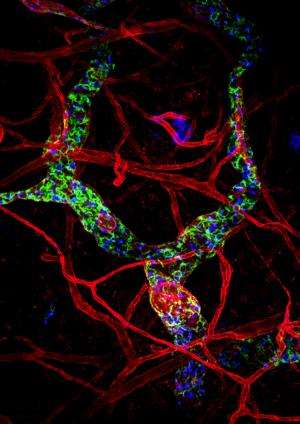January 18, 2013 report
New study confirms immune cells are guided by gradients

(Medical Xpress)—A group of researchers in Austria and Switzerland has for the first time proven that immune cells migrate along chemical concentration gradients. This process has long been assumed but never demonstrated experimentally in living tissues.
Immune cells are known to leave the blood stream and migrate through tissues in search of bacteria, viruses, and other invaders, and then enter lymphatic vessels and return to the circulation system. Now the new research confirms exactly how they move through the tissues and find their way out again.
It was thought that immune cells are guided through tissues along gradients of chemokines, which are a class of proteins secreted by cells and known to guide the movement of cells during embryonic development. Cancer cells are also thought to follow the same gradients to disseminate in the body. This process had been assumed and demonstrated in cell cultures but had never before proven in vivo.
The researchers, led by Assistant Professor Michael Sixt of the Institute of Science and Technology Austria, studied interstitial dendritic cells (a type of leukocyte or white blood cell) in the skin of mice and a chemokine called CCL21. Through quantitative imaging, they were able to watch the cells navigating through the tissues.
Chemokines were formerly known as cytokines, and there are several different families of these proteins. The C-C chemokines are so called because they have two adjacent cysteines. In humans, CCL21, or Chemokine (C-C motif) ligand 21, is expressed by a gene on chromosome 9.
The scientists showed that CCL21 is produced by the endothelial cells in the lymphatic vessel and the chemokine then spreads out into the tissues to form a steeply decaying concentration gradient. They were able to map out the gradients and compare these with the migration routes actually taken by the immune cells, and proved that from a distance of about 90 micrometers the cells followed the concentration gradient and located the lymphatic vessel by moving towards the greater concentration of CCL21.
The researchers were also able to demonstrate that the concentration gradients were bound to the tissues (immobilized) and not soluble. They did this by swamping the gradients by adding extra chemokine and by delocalizing the chemokine, which is immobilized to heparan sulfates. The process of migration following immobilized concentration gradients is known as haptotaxis.
Their paper was published in the journal Science.
More information:
Interstitial Dendritic Cell Guidance by Haptotactic Chemokine Gradients, Science, 18 January 2013: Vol. 339 no. 6117 pp. 328-332
DOI: 10.1126/science.1228456
ABSTRACT
Directional guidance of cells via gradients of chemokines is considered crucial for embryonic development, cancer dissemination, and immune responses. Nevertheless, the concept still lacks direct experimental confirmation in vivo. Here, we identify endogenous gradients of the chemokine CCL21 within mouse skin and show that they guide dendritic cells toward lymphatic vessels. Quantitative imaging reveals depots of CCL21 within lymphatic endothelial cells and steeply decaying gradients within the perilymphatic interstitium. These gradients match the migratory patterns of the dendritic cells, which directionally approach vessels from a distance of up to 90-micrometers. Interstitial CCL21 is immobilized to heparan sulfates, and its experimental delocalization or swamping the endogenous gradients abolishes directed migration. These findings functionally establish the concept of haptotaxis, directed migration along immobilized gradients, in tissues.
© 2013 Medical Xpress














